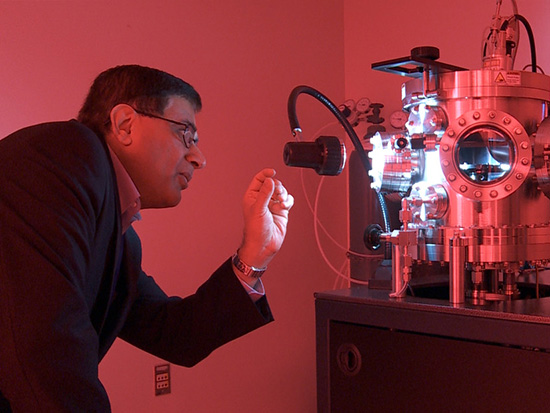 Yogesh Vohra Yogesh Vohra, Ph.D., is a co-principal investigator on a National Science Foundation award that will bring the University of Alabama at Birmingham about $2 million over five years.
Yogesh Vohra Yogesh Vohra, Ph.D., is a co-principal investigator on a National Science Foundation award that will bring the University of Alabama at Birmingham about $2 million over five years.
The total NSF EPSCoR Research Infrastructure Improvement Program award of $20 million — with its principal investigator Gary Zank, Ph.D., based at the University of Alabama in Huntsville — will help strengthen research infrastructure at UAB, UAH, Auburn University, Tuskegee University, the University of South Alabama, Alabama A&M University, Alabama State University, Oakwood University, and the University of Alabama.
The award, “Future technologies and enabling plasma processes,” or FTPP, aims to develop new technologies using plasma in hard and soft biomaterials, food safety and sterilization, and space weather prediction. This project will build plasma expertise, research and industrial capacity, as well as a highly trained and capable plasma science and engineering workforce, across Alabama.
Unlike solids, liquids and gas, plasma — the fourth state of matter — does not exist naturally on Earth. This ionized gaseous substance can be made by heating neutral gases. At UAB, Vohra, a professor and university scholar in the UAB Department of Physics, has employed microwave-generated plasmas to create thin diamond films that have many potential uses, including super-hard coatings and diamond-encapsulated sensors for extreme environments. This new FTPP grant will support research into plasma synthesis of materials that maintain their strength at high temperatures, superconducting thin films and developing plasma surface modifications that incorporate antimicrobial materials in biomedical implants.
 Vohra says the UAB Department of Physics will mostly use its share of the award to support faculty in the UAB Center for Nanoscale Materials and Biointegration and two full-time postdoctoral scholars, and support hiring of a new faculty member in computational physics with a background in machine-learning. “The machine-learning predictions using the existing databases on materials properties will enable our research team to reduce the time from materials discovery to actual deployment in real-world applications,” Vohra said.
Vohra says the UAB Department of Physics will mostly use its share of the award to support faculty in the UAB Center for Nanoscale Materials and Biointegration and two full-time postdoctoral scholars, and support hiring of a new faculty member in computational physics with a background in machine-learning. “The machine-learning predictions using the existing databases on materials properties will enable our research team to reduce the time from materials discovery to actual deployment in real-world applications,” Vohra said.
The NSF EPSCoR Research Infrastructure Improvement Program helps establish partnerships among academic institutions to make sustainable improvements in research infrastructure, and research and development capacity. EPSCoR is the acronym for Established Program to Stimulate Competitive Research, an effort to level the playing field for states, territories and a commonwealth that historically have received lesser amounts of federal research and development funding.
Jurisdictions can compete for NSF EPSCoR awards if their five-year level of total NSF funding is less than 0.75 percent of the total NSF budget. Current qualifiers include Alabama, 22 other states, and Guam, the U.S. Virgin Islands and Puerto Rico.
Besides Alabama, the other four 2022 EPSCoR Research Infrastructure Improvement Program awardees are Hawaii, Kansas, Nevada and Wyoming.
In 2017, UAB was part of another five-year, $20 million NSF EPSCoR award to Alabama universities.
The Department of Physics is part of the UAB College of Arts and Sciences.